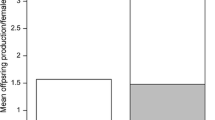Summary
Life-history strategies, ranging from completely free-living types to obligate entoparasitism, through ectocommensalism, ectoparasitism, and entocommensalism, are discussed within the framework provided by the concepts of r- and K-selection. In r-selection density and competition effects are minimal and progeny output (fecundity) can be maximised, while in K-selection competition is keen and the premium is on adult survival with production of a smaller number of extremely fit offspring. Thus r-strategists, with high fecundity, can be expected to have low calorific values because their resources are channelled into production of the maximum number of progeny, while K-strategists will have high calorific values based on lipid reserves which buffer the adults against possible reductions in food supply. This negative relationship between fecundity and calorific value is found in the phylum Platyhelminthes, with entosymbiotes at one end of the spectrum (high fecundity, low calorific value) and ectocommensals and free-living species at the other (low fecundity, high calorific value). This puts the entosymbiotes as more r-selected than the ectocommensal and free-living species, with the ectoparasites occupying an intermediate position. However, it is argued that parasites, and particularly entoparasites, follow both an r- and K-strategy at the same time and that this is only possible because of the stable, nutrient-rich environment provided by the host. Evolutionary theory dictates that all species would follow an r- and K-strategy simultaneously but environmental conditions force them into one alternative or another. Consequently the high fecundity of entoparasites, which has hitherto been viewed as a specific adaptation to entoparasitism, is now viewed as an automatic consequence of the conditions provided by the parasitic environment.
Similar content being viewed by others
References
von Brand, T.: Biochemistry of parasites, p. 1–429. Oxford-New York: Oxford University Press 1966
Calow, P.: The relationship between fecundity phenology and longevity: a systems approach. Am. Naturalist 107, 559–574 (1973)
Calow, P., Jennings, J. B.: Calorific values in the phylum Platyhelminthes: the relationship between potential energy, mode of life and the evolution of entoparasitism. Biol. Bull. 147, 81–94 (1974)
Chandler, A. C. Introduction to Parasitology, 8th ed., p. 1–756. New York: Wiley 1955
Cummins, K. W., Wuychek, J. C.: Caloric equivalents for investigations in ecological energetics. Mitt. Int. Ver. Theor. Angew. Limnol. 18, 1–158 (1971)
Hairston, N. G., Smith, F. E., Slobodkin, L. B.: Community structure, population control and competition. Am. Nat. 104, 592–597 (1960)
Hyman, L. H.: The invertebrates: Platyhelminthes and Rhynchocoela. The acoelomate Bilateria, vol. II, p. 1–550. New York: McGraw-Hill 1951
Jennings, J. B.: A new temnocephalid flatworm from Costa Rica. J. Nat. Hist. 2, 117–120 (1968)
Jennings, J. B.: Parasitism and commensalism in the Turbellaria. In: B. Dawes, ed., Advances in parasitology, vol. 9, p. 1–32. New York-London: Academic Press 1971
Jennings, J. B.: Symbioses in the Turbellaria and their implications in studies on the evolution of entoparasitism. In: Symbioses in the sea, W. B. Vernberg, ed., p. 127–160. Columbia, S. Carolina: University of South Carolina Press 1973
Lack, D.: The natural regulation of animal numbers, p. 1–343. Oxford-New York: Oxford University Press 1954
MacArthur, R. H., Wilson, E. O.: The theory of Island Biogeography, p. 1–203. Princeton, N. Jersey: Princeton University Press 1967
Pianka, B. R.: On r- and K-selection. Am. Naturalist 104, 592–597 (1970)
Reynoldson, T. B.: A quantitative study of the population biology of Polycelis tenuis (Ijima) (Turbellaria, Tricladida). Oikos 11, 125–141 (1960)
Reynoldson, T. B.: Environment and reproduction in freshwater triclads. Nature (Lond.) 189, 329–330 (1961)
Reynoldson, T. B.: The distribution and abundance of lake-dwelling triclads—towards a hypothesis. In: Advances in ecological research, J. B. Cragg, ed., vol. 3, p. 1–71. New York-London: Academic Press 1966
Reynoldson, T. B., Young, J. O., Taylor, M. C.: The effect of temperature on the life-cycle of four species of lake-dwelling triclads. J. An. Ecol. 34, 23–43 (1965)
Slobodkin, L. B., Richman, S.: Calories/gm. in species of animals. Nature (Lond.) 191 299 (1961)
Smyth, J. D.: Animal parasitology. p. 1–470. London: The English Universities Press 1962
Wigglesworth, V. B.: The principles of insect physiology, 8th ed., p. 1–741. London: Methuen 1965
Author information
Authors and Affiliations
Rights and permissions
About this article
Cite this article
Jennings, J.B., Calow, P. The relationship between high fecundity and the evolution of entoparasitism. Oecologia 21, 109–115 (1975). https://doi.org/10.1007/BF00345553
Received:
Issue Date:
DOI: https://doi.org/10.1007/BF00345553




